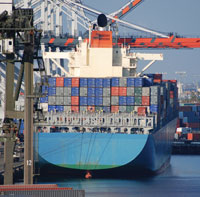
A Port in the Storm
Maritime facilities leverage advanced technology for TWIC compliance
- By Megan Weadock
- Jun 03, 2009
While federal security requirements
like the Transportation
Workers Identification Credential
program are designed with the safety
of the nation in mind, adhering to them can
be a costly and time-consuming task.
The goal of the TWIC program is to
ensure that anyone who has unescorted
access to secure areas of U.S. port facilities
and vessels has received a thorough
background check and is not a known security
threat. The Transportation Security
Administration recently announced that it
has reached a major milestone: 1 million
port and longshore workers, truckers and
others at ports across the nation have enrolled
in the TWIC program.
But in response to the stringent TWIC
requirements, a new trend is emerging.
The U.S. maritime industry includes more
than 180 ports—some of which are looking
for ways to use advanced technology
to gain leeway under the program and save
on both financial and time investments.
A Step Ahead
TWIC is a common identification credential
for all personnel that require
unescorted access to secure maritime facilities
and vessels. The program is part of
the Maritime Transportation Security Act
of 2002, which aims to protect U.S. ports
and waterways from the possibility of terrorist
attack. The card is tamper resistant
and contains each worker's biometric fingerprint
to create a positive link between
the cardholder and the card.
The Virginia Port Authority and the
Port of Wilmington have received approval
from the Coast Guard to leverage security
technology to achieve TWIC compliance.
At each port, these developments
will allow officials to grant access to visitors
who don't have a TWIC card but are
trusted agents within the industry—for
example, an overland truck driver entering
the port to further transship goods.
At these ports, the fl ow of workers and
traffic waxes and wanes seasonally. Often,
someone seeking access to the port won't
have TWIC identification and will therefore
require an escort. On busy days, this
could mean escorting hundreds of trucks
and visitors.
In Virginia, the Port Authority has
started a new program, called Trusted
Agent, using Orsus' situational management
software platform, Situator, to monitor
visitors who don't have a TWIC card.
Trusted visitors can now access secure
areas of the port—unescorted—by carrying
a Nextel Sprint phone equipped with a
radio and navigational system from Xora
Co. When paired up with Situator, the
system gives command center operators
the ability to track and monitor each visitor's
whereabouts while on port property.
If he or she enters a restricted area or if
the device doesn't move for a predefined
period of time, operators can directly contact
the visitor on the phone or dispatch a
security official to the location.
Meanwhile, at the Port of Wilmington
in Delaware, officials have started using
Siemens Siveillance SiteIQ video surveillance
system to keep an eye on truckers
and port visitors who don't have a TWIC
card. With SiteIQ, vehicles are greeted at
the gatehouse, where drivers are identifi
ed and then allowed to pass. Each visitor
is digitally monitored at the point of entry
and tracked with analytics as he or she
moves throughout the facility. As at the
Virginia Port Authority, any unauthorized
movement into restricted areas is instantly
fl agged and dealt with accordingly.
For the ports' operators, this new development
brought a sigh of relief.
"The Coast Guard advised us that if
we were able to ensure 24/7 monitoring of
certain secure areas that we use for vehicle
staging and other operational reasons, we
would not have to provide physical escorts
for vehicles and their drivers," said Patrick
J. Hemphill, manager of port security at
the Port of Wilmington. "This will help
us reduce our costs involved with TWIC
compliance and implementation."
Cost, Time Savings
Solutions like Orsus' Situator and Siemens
SiteIQ allow ports to boost operational effi
ciency and trim compliance costs—but
without compromising security.
The drawn-out enrollment process is
one obvious reason why the use of customized
technology solutions for trusted
port visitors simply makes sense. From
the looks of TSA's Web site, getting a
TWIC card is a time-consuming process.
The worker must pre-enroll by providing
biographic information and then
schedule an appointment at an enrollment
center. At the enrollment center, he
or she must provide acceptable identity
documents, fill out a range of forms, get
fingerprinted, sit for a digital photograph
and pay a $132.50 fee. Once the TWIC
card is ready—which usually take three
to four weeks—the worker has to return
to that specific enrollment center to pick
up the credential.
And at $132.50, the card can be expensive
for one-time visitors. On the other
hand, when a worker who is enrolled in
the TWIC program forgets his or her card,
an escort is required, which requires even
more time and financial investment from
the Port Authority—all for a single visitor.
In a time where the concept of cost savings
is a must to any organization, tapping
a port's existing security infrastructure to
ensure TWIC compliance only makes
sense. This new trend only goes to prove
that at places like the Port of Wilmington
and the Virginia Port Authority, necessity
really is the mother of invention.
This article originally appeared in the issue of .